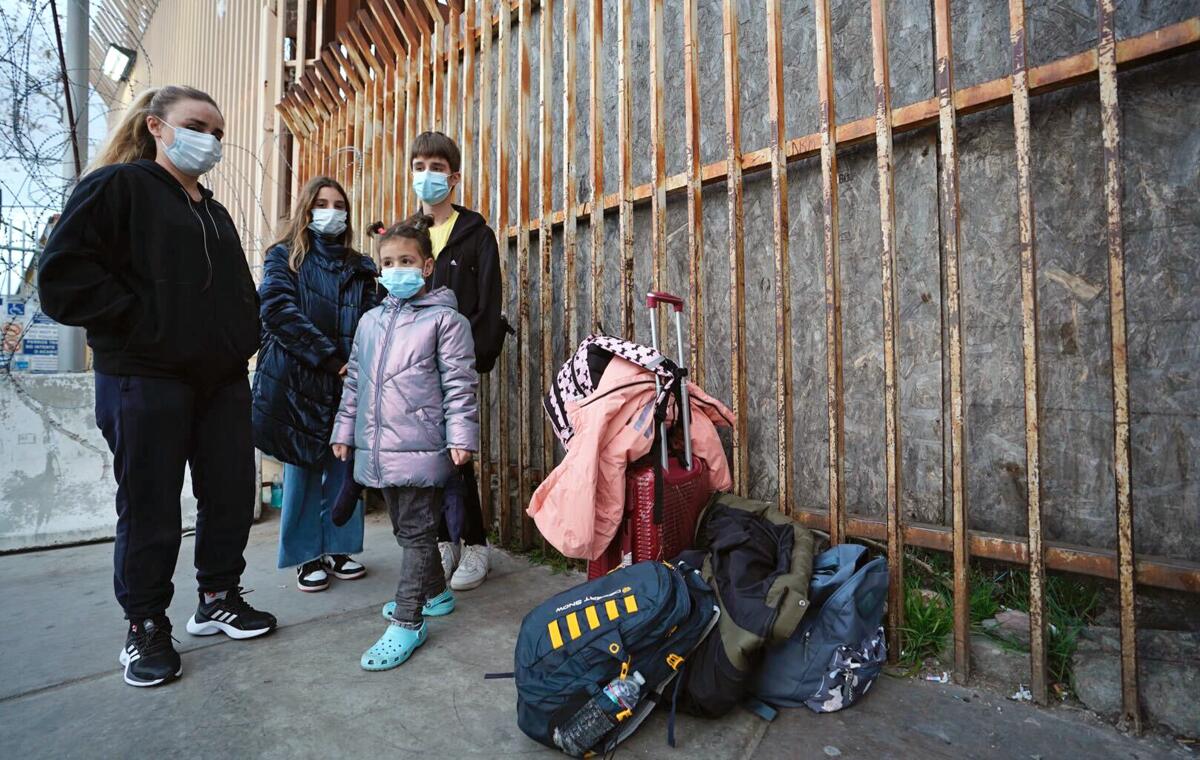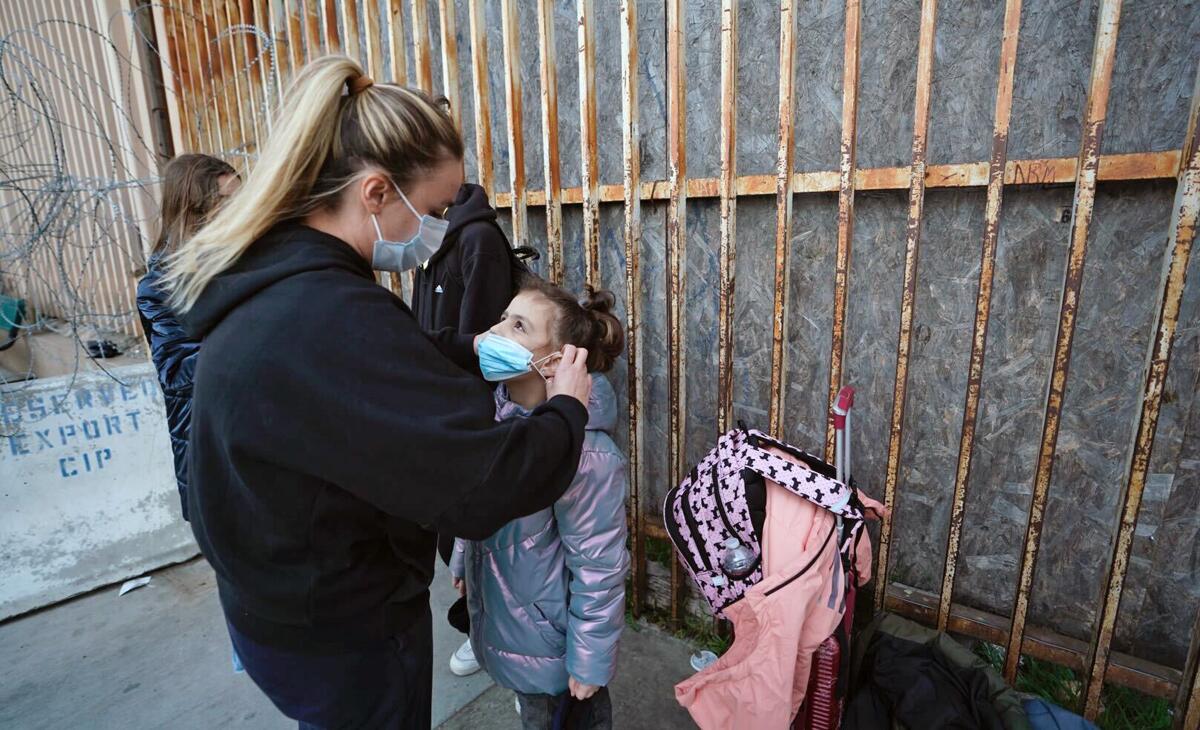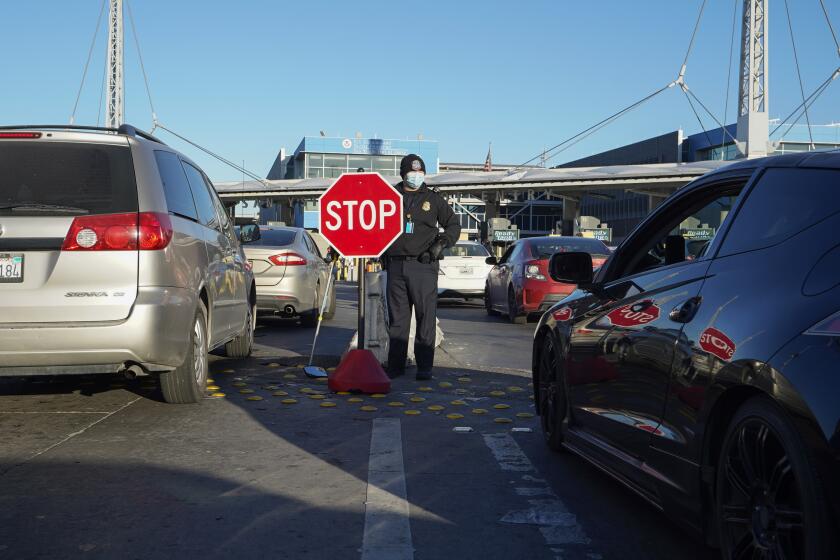Ukrainian family fleeing Russian invasion turned away from U.S. border

A woman and her three children tried to request asylum at the San Ysidro Port of Entry, but Customs and Border Protection officials told them they couldn’t come in.
- Share via
U.S. border officials in San Diego on Wednesday turned away a Ukrainian family that was seeking asylum after fleeing the Russian invasion.
The 34-year-old mother, who asked to be identified as Sofiia, and her three children, ages 14, 12 and 6, said that when she fled her country she headed toward the only relatives she has outside of Ukraine, U.S. citizens who live in California. But she was turned back under the same border policies that have stopped asylum seekers from around the world and stranded thousands of them in Tijuana for years.
“I’m not asking for anything from the United States, just to be let in,” Sofiia said. “All we need is to be safe. All we want is to keep our lives safe.”
She has a typed letter from her U.S. relatives explaining who she is and promising to take care of her living expenses.
A spokesperson from Customs and Border Protection said that the agency is “looking into the situation.”
While the United States offered “temporary protected status” to Ukrainians already living in the U.S. when the invasion began, that protection from deportation does not extend to new arrivals fleeing the Russian invasion. Any Ukrainians who make it to the U.S. border will have to navigate the same restrictions that have sent thousands of other asylum seekers back to Mexico to face the threats of kidnappings, assaults and other violent attacks.
U.S. border policies have increasingly limited asylum seekers’ access to U.S. soil and to the legal process to screen them to determine whether they qualify for protection.
The most restrictive policy, and the most recently implemented, is known as Title 42, which was put in place at the beginning of the pandemic by the Trump administration and was continued by President Biden. Under Title 42, border officials can keep out asylum seekers and other migrants and expel them to the country from which they entered the United States, or to their country of origin if they try to cross without permission, without screening them.
Both administrations have argued that Title 42 is necessary to protect against the spread of coronavirus in the United States. Critics of the policy, including immigration attorneys and public health experts, have long disagreed. A panel of federal appellate judges recently called that argument into question in light of the availability of vaccines and loosening of pandemic restrictions.
The CBP spokesperson said that Title 42 remains in effect, and that the Department of Homeland Security can exempt “particularly vulnerable individuals” from expulsion on a case-by-case basis.

Sofiia only learned about the policy after she was turned away from the border twice — once in a car and once on foot.
She had been a Hebrew teacher in Ukraine.
Her family members in California urged her to get out. She had to leave behind most of her loved ones, including her mother, and drove her car to Moldova, then Romania.
“I left a little bit before it got too tough, but now my family can’t even leave their houses. It was my luck I listened to my friends,” Sofiia said. “I was afraid for my kids. That’s why I left.”
Her eyes welled with tears as she spoke about her family still in Ukraine. They have told her that they’re running out of food and medicine, and there’s no gas.
“My mom is sitting in the basement,” she said.
Gas already was running out when she left. The gas stations would only allow people to fill 20 liters — roughly 5 gallons — per car. She had to pause frequently to add more to her tank, which delayed her trip significantly because the lines at the pumps were long.
She left the car in Romania, and the family flew through Frankfurt to Mexico City. They arrived in Tijuana on Monday.
Her relative drove down from Los Angeles to pick up her and her children and tried to drive them north across the border at the San Ysidro Port of Entry.
Ports of entry are still not processing asylum seekers who arrive on foot, so some have resorted to driving onto U.S. soil to request protection
When his car reached within inches of U.S. soil , the relative spoke with the CBP officer stationed there. CBP has stationed officers at the yellow line that marks the border since asylum seekers started trying to get to U.S. soil to request protection by driving into the country as a way around some of the border restrictions.
Her relative explained to the officer that he was a U.S. citizen and that his family was fleeing the war. He asked what he needed to do for them to be able to enter with him. The officer told him that he could not cross with them and turned the car around.
He took Sofiia and her children to a Tijuana hotel. The U.S.-based relatives then contacted the U.S. consulate in Tijuana and asked for help to get permission for the family to enter. They didn’t get a response, Sofiia said.
On Wednesday Sofiia decided to try walking through the pedestrian lane at San Ysidro Port of Entry and requesting asylum that way. But officers stationed at the border line wouldn’t let her onto U.S. soil.
As soon as the officer at the line saw her passport, she said, he waved her to the side. She waited there with her children.
Eventually, another officer asked her through the fence why she was standing there.
“I was trying to explain to him, but he told me there is no way to come in,” she said. “He didn’t want to listen. He just left.”
She stayed standing by the fence, in shock.
A Mexican police officer came and was filming her when an immigration attorney who happened to be in line noticed the situation.
Blaine Bookey, the legal director for the Center for Gender and Refugee Studies at UC Hastings, stepped forward to help Sofiia, who was crying and so overwhelmed she was unable to speak.
After four or five hours of standing by the entrance to the United States, a small group of immigration attorneys and advocates had formed around her, messaging their contacts in CBP and posting Sofiia’s story on Twitter.
CBP still wouldn’t let her in. The Mexican police officer came back and asked the group to leave.
Sofiia decided to walk back to a hotel to get her children out of the cold.
“We left our lives, our jobs, our families and houses in Ukraine just to escape from this horrible war,” she said. “All my friends and family are far, far away from me, and I don’t know if they will be alive tomorrow. I just want to keep my kids’ lives safe.”
More to Read
Updates
2:02 p.m. March 10, 2022: This article was updated with information from Customs and Border Protection.
Sign up for Essential California
The most important California stories and recommendations in your inbox every morning.
You may occasionally receive promotional content from the Los Angeles Times.












